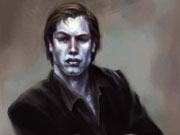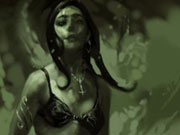Vampire: The Masquerade - Bloodlines Designer Diary #2
In this second edition of our designer diaries, Troika Games joint CEO Jason Anderson describes how the team is designing Vampire's gameplay.
Bloodlines will be an ambitious hybrid action/role-playing PC game played from a first-person perspective using the rules and setting of the popular Vampire: The Masquerade tabletop role-playing game. In the new game, you'll play as a fledgling vampire in a dark and dangerous near-future version of Los Angeles, where the streets are ruled by immoral humans and rival vampires--and worse things. Bloodlines is in development at Troika Games, whose founders include the creators of Fallout and Arcanum. Cofounder and joint CEO Jason Anderson joins us for this edition of our designer diaries to discuss how the development team went about making the Vampire tabletop game work as a computer game.
Putting the Game Into the Game
Joint CEO, Troika Games/Designer
Having spent the past six years of my life creating the worlds of Fallout and Arcanum, I knew that I would find working with the world of Vampire: The Masquerade a welcome change. No more elves. No more dwarves. Thank you very much. Perhaps in a year or two. I was actually going to get to create a game about vampires. Cool.
But wait...I'm a Dungeons & Dragons fan at heart. I had never played the Vampire: The Masquerade tabletop game. I obviously knew what it was; I'd even read the second-edition source book years ago. I was a fan of the genre but had never actually played the game. It looked like it was time to do a little research.
It was apparent that the first order of business was to figure out exactly what it was that made Vampire cool to play. Not as easy an answer as you would think. I knew that the dark, gothic-punk world was cool, and the overall feeling of the world was similar to those of movies like The Crow and Blade. This, in its own right, would make the game remarkable. But what did the people who played the game take away from it when they were finished? What kept them coming back for more? It couldn't just be the setting, which can be found in plenty of books and movies. There had to be something more.
Luckily for me we had people at Troika who had played the pen-and-paper version of Vampire. We are a game company, after all. This knowledge base was indispensable to my research and came with a full collection of second-edition books to boot.
And so the brain-picking began, along with the reading of all of the second-edition source material. Then it was on to all of the revised editions. By the end of this, my team and I had a fairly solid understanding of the game itself. But even with all of this knowledge, and the firsthand experience some of our employees had playing the pen-and-paper game, we needed more information in order to pinpoint the exact element we were looking for. It was time to brave the Internet.
I searched out fan sites for Vampire all over the Internet. Let me just say this...I have seen things you people wouldn't believe. And though I may be scarred for the rest of my life, I found what I was looking for. Reading the fan sites, I found page after page of fans retelling their role-playing experiences. The main theme on most of these pages seemed to be character interaction.

Vampire's role-playing seemed to be firmly rooted in character interaction, and stats, items, and powers took a backseat. Fans spoke most often of their characters' associations, whom they had spoken with, and how they had become entrenched in the intricacies of vampiric society. They focused very little on how many character points they had or what item they had obtained. I also discovered that the world itself was very important to the fans' role-playing experience. Unlike many other role-playing games, where the world is static, the world of Vampire is constantly evolving.
Finally feeling like I had a good grasp on the pen-and-paper game, it was time to figure out how to bring that experience to a computer game. Let me begin by saying that I am a firm believer in trying to reproduce as much of the pen-and-paper experience as possible in a computer game. There are two reasons for this. First, it keeps the game familiar to the core fans of the pen-and-paper game. These are the people who will initially buy the game. The last thing I want to do is get a wave of negative reviews from the core fan base. Second, I'd like the computer game to resemble the pen-and-paper game as closely as possible so that those people who have never before set eyes on the setting get an accurate introduction. I want them to be able to experience a true Vampire game--to whet their appetite for the genre. Ideally, the computer game experience will leave them wanting more and thus lead them to the pen-and-paper game.
But here's the rub: Tabletop role-playing games do not translate well into computer games, especially real-time computer games. Dice rolls and randomness are fun, even if you are failing, when you are around a table filled with friends. They are not at all fun while sitting alone in front of your computer. Let me explain with two scenarios--the first a tabletop experience, the second in front of a monitor.

Pen-and-paper game: John levels his Desert Eagle at the sabbat war ghoul. With a perception attribute of five and a firearms score of three, there is no way he could miss. A fist full of dice hit the table, quickly followed by several gasps from those seated around the table. John's friend breaks character and starts busting up laughing. Not only did John miss, but he rolled four ones, which equates to a botch. The storyteller informs John that his gun has misfired. The slide blew back, hitting him in the face and taking half of his health. Then the storyteller continues..."The war ghoul, seeing that John is not an immediate threat, turns his attention towards his friend." John's friend is not laughing now, but John chuckles a bit.
Computer game: John levels his Desert Eagle at the sabbat war ghoul. With a perception attribute of five and a firearms score of three, there is no way he could miss. He fires. His gun explodes in his hands and takes half of his health. Loud cursing is quickly followed by the sounds of keyboard and mouse being smashed and thrown about. "What?! There is no way I should have missed that!!!" John helplessly shouts at his monitor. It takes the war ghoul two hits to send the now unarmed John to his final death. John's next thought: "Did I save the receipt for this game? Can I still return it?"
Don't worry. This isn't where I say we threw out the entire Vampire system in order to accommodate a more-exciting, action-packed computer game experience. Remember, this is our job as game designers--to make the pen-and-paper game work in a computer game environment.
First, we looked over the pen-and-paper system, looking for things that would work equally well in both systems and bringing them straight across. A large portion of the pen-and-paper game character system went in smoothly. All of the character attributes from Vampire were easily implemented into the computer game.
However, while all attributes made sense in the computer game, not all of the abilities did. For instance "knowledge of law" would not be useful enough in a computer game to justify spending points on, so we removed it. All in all, abilities were cut down from the 30 in the pen-and-paper game to a total of 15 for the computer game.
Next we looked at all of the derived feats and their frequency of use. For those feats that are used often in the game, dice rolls work well, and we translated them directly from the pen-and-paper game. But for those feats that are used seldom, dice rolls are trickier.
If you have a feat that gets used only 20 times in the game, it is inevitable that people will make bad rolls in at least a few of these 20 times, which makes the feat itself seem broken. So, rather than use random dice rolls on these types of feats, we went with a straight level-of-difficulty contest. This way the feats would work in the computer game as they were intended in the pen-and-paper game.
Another place where dice rolls didn't work was in the area of falling damage. When we followed the pen-and-paper game rules from Vampire, the damage you received from a fall was random. Moderate jumps would sometimes inflict extreme damage, while falling off a building might barely give you a scratch. Everyone was complaining that [the way we had implemented] falling was broken. So we removed the random dice roll and implemented a straightforward scale based on the velocity at which you hit the ground. Everyone was happy.
Our biggest challenge to implement, and probably our largest deviation from the pen-and-paper game, was in the area of disciplines. In the pen-and-paper game, each discipline was used in a very different manner. Some required a little blood and a lot of time to use, others required no blood at all and could be used whenever the player wished. Not only was this true of each individual discipline, but often within a single discipline, the different levels had varying requirements. This was too confusing to implement into a computer game, where controls must be simplified and streamlined for ease of use and understanding.

So we went about the task of equalizing and streamlining the various disciplines and their levels for our game. Wherever possible, we kept the effects of a discipline intact and unchanged. And for the sake of consistency, we adjusted the cost of using each of the disciplines. One blood point is spent for a first-level effect, two blood points for a second-level effect, and so on.
Whew, we made it. The groundwork was laid out. Now for the hard part...the story.
Our firm understanding of the world and a clear idea of how the game system would work would serve as a guideline in creating our story. As you may know, creating an original, entertaining story is not easy. Creating this story with a group of talented, strong-willed individuals, now that's a challenge!
But I have gone on far enough for today. You will have to wait for the next installment to hear about the screaming, yelling, cursing, and tears. (And that was just from Chad!) Until next time.
Got a news tip or want to contact us directly? Email news@gamespot.com
Join the conversation